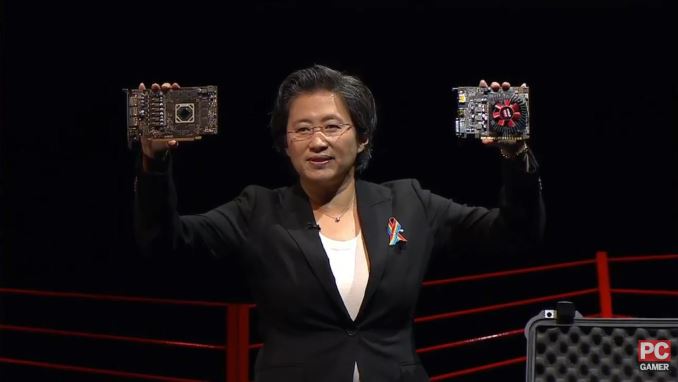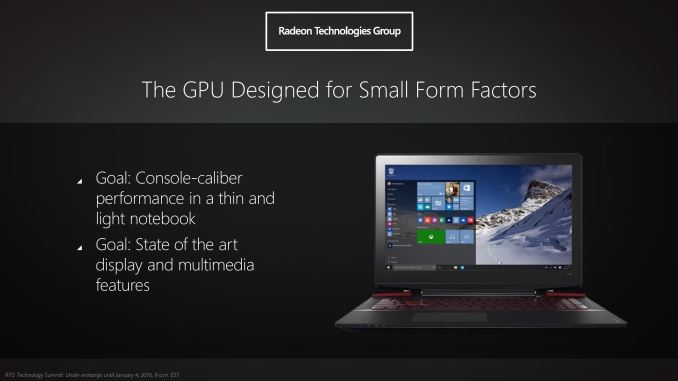AMD Teases Future Radeon RX 470 & Radeon RX 460 Cards
by Ryan Smith on June 13, 2016 3:30 PM EST
With the annual Electronic Entertainment Expo once again upon us, this week has been a flood of gaming hardware and software news. On the PC front, AMD is once again sponsoring PC Gamer’s PC Gaming Show, and while the company isn’t making quite as large of a presence this year – having just announced a bunch of tech at Computex – AMD is still attending E3 to tease a bit of hardware. Announced in a press release that’s going out at the same time as the PC Gaming Show starts, AMD is very briefly teasing the next two Polaris-based Radeon cards: the Radeon RX 470 and the Radeon RX 460.
AMD previously teased the Radeon RX 480 back at Computex, and with that card not shipping until the end of this month, the RX 470 and RX 460 are even more brief teases, essentially amounting to AMD confirming that they will exist.
As you can assume from the numbers, the RX 470 and RX 460 will slot in below the $199 RX 480. AMD’s press release specifically notes that the RX 470 is a “refined, power-efficient HD gaming” card. Whereas the RX 460 is a “a cool and efficient solution for the ultimate e-sports gaming experience.” These are no further details such as performance, specifications, or pricing, so this is a true teaser in every sense of the word.
Based on their admittedly short descriptions, it sounds like the RX 470 and RX 460 will slot in to very similar positions as the R7 370 and R7 360 respectively, as these are the same markets AMD pitched those cards at. This would make the RX 470 a budget 1080p card, while RX 460 is pitched specifically at MOBA players and the like, as those games have relatively low system requirements. Lower-end cards of this nature have also proven very popular in China, where MOBAs are especially popular and the pricing is better aligned with what most consumers can afford.
For what it’s worth, those cards launched at $149 and $109 respectively, so that may give us a ballpark idea of what to expect. Note that AMD only has two Polaris chips – the larger Polaris 10 and the smaller Polaris 11 – so it’s not clear how AMD may split these up. Historically, Radeon x60 cards have been based on chips that have been prevalent in smaller, mid-performance laptops.
On that note there’s one last passage from AMD’s press release I want to point out. In reiterating their talking point about bringing “console-like” performance to thin and light laptops, AMD’s release mentions that Polaris offers “exceptionally low power and low-z height.” Like everything else, no further details are provided, but I don’t suspect this is the last we’ve heard of this point. Having seen a very early Polaris 11 last December it’s definitely a small chip, and it sounds like AMD focused not just on package size, but thickness as well. Z-height is not something I’ve previously paid attention to, so I’m not immediately sure how thick AMD’s last-generation chips were, or whether this has been much of a problem on a competitive basis.












105 Comments
View All Comments
stanleyipkiss - Monday, June 13, 2016 - link
So AMD have cornered virtually every market available except for the 4K/high-end one. The 480 will do wonders at its price-point for 1440p at 60fps. The 470 will make 1080p at 60fps at $150. And the 460 will make sure you can run DOTA and LoL at 60fps at $100. Bases are covered. All that's left is the monster that is Vega, coming for Christmas or Spring 2017Rampart19 - Monday, June 13, 2016 - link
Agreed. The 460 will be a great card for less demanding titles at 1080p. I'm curious to see what sort of power requirements it has and the physical size of the card as I have some friends that could use an upgrade but only have store bought, standard PCs.Eden-K121D - Tuesday, June 14, 2016 - link
460 could do 720P and 900P at 60FPS and that could be a selling point in a developing country where even 1080P monitors are rare as hellflipflopxx - Monday, June 13, 2016 - link
cmon Ryan. The z-height is about the notebook not the chip itself.Gaming notebooks are the size of the packaging of a regular nb due to the cooling required...
ToTTenTranz - Monday, June 13, 2016 - link
Gaming notebooks won't use Polaris 11, they'll use Polaris 10. Like previous gaming notebooks used Pitcairn with a similar power budget (up to +/- 100W).Polaris 11 is set to go into sub-notebooks, and the z-height factor should be important for models that push design limits, like e.g. the Surface Book.
flipflopxx - Monday, June 13, 2016 - link
1. What is the definition a "gaming notebook" for you? polaris 11 is probably faster than R9 M390. AMD is tallking about "Console-class GPU performance for thin and light notebooks "2. Height is important for all notebooks not just the surface book.
3. What does your reply say about the fact that it's not about chip height, but notebook height? read the press release. That's all my original post said.
Hrobertgar - Tuesday, June 14, 2016 - link
The AMD statement that mentions z-height also mentions thin notebooks, which would be redundant if AMD was not talking about the chip and its systems. I think thin for a notebook is often driven by cooling and thermals. Maybe this chip has advantages in this area.Beararam - Monday, June 13, 2016 - link
It'll be interesting to see which review is done first: The 960, 1080, or 1060. Any bets?vladx - Monday, June 13, 2016 - link
1080 review will come first for sure, you can quote me later. ;)catavalon21 - Monday, June 13, 2016 - link
No bets, but I am hoping that as soon as AMD NDAs are lifted for the 480, there is a comprehensive head-to-head of 1080, 1070, and 480, with 970/960/390/380 on down in the mix. And by comprehensive, not just games but also a sincere mix of compute tasks, those at which both NVIDIA and AMD have exceled at (Single and double precision). That I would be quite content with.